Research
Why you should start with the audience on Twitter this holiday

We asked the people on Twitter about their feelings, thoughts and plans for the holidays, and uncovered eight insights marketers in Asia Pacific should keep top of mind this season.
Twitter’s audience is among the most engaged and receptive, and that’s especially true during the holidays. Our audience turns to Twitter during the holiday season to look for the best deals, share recipes and travel tips, and, of course, let others know what they’re shopping for. And regardless of whether they’re shopping on 12-12 Online Shopping Day, or any other day leading up to the Christmas and New Year holidays, people flock to Twitter for insights into what to buy.
If you’re launching something new this holiday season, you need to get in front of Twitter’s audience. People on Twitter are 31% more likely than those off of Twitter to be the first to buy new products.1 And their purchases could have a ripple effect too, as two-thirds of people on Twitter influence the purchases of family and friends.2
The holidays are fertile ground for any marketer, and Twitter can help you fine-tune your strategy with conversation data that offers new insights into holiday shopper behavior. Here are the important holiday insights marketers in Asia Pacific need to know in order to navigate the biggest shopping moment of the year.
1. The Twitter audience are feeling good about the holidays.
To people on Twitter, the holiday season is a moment they feel good about. We can learn from holiday Tweets about who is Tweeting, how they are feeling, and even what emoji they like to use. And all these can lead to insights that help brands better connect with our audience during the holiday season. With positive emotions such as excitement and happiness running high ahead of the holiday season, advertisers can tailor creative messaging that foster positive feelings or alleviate negative emotions to drive greater connection with their customers on Twitter.
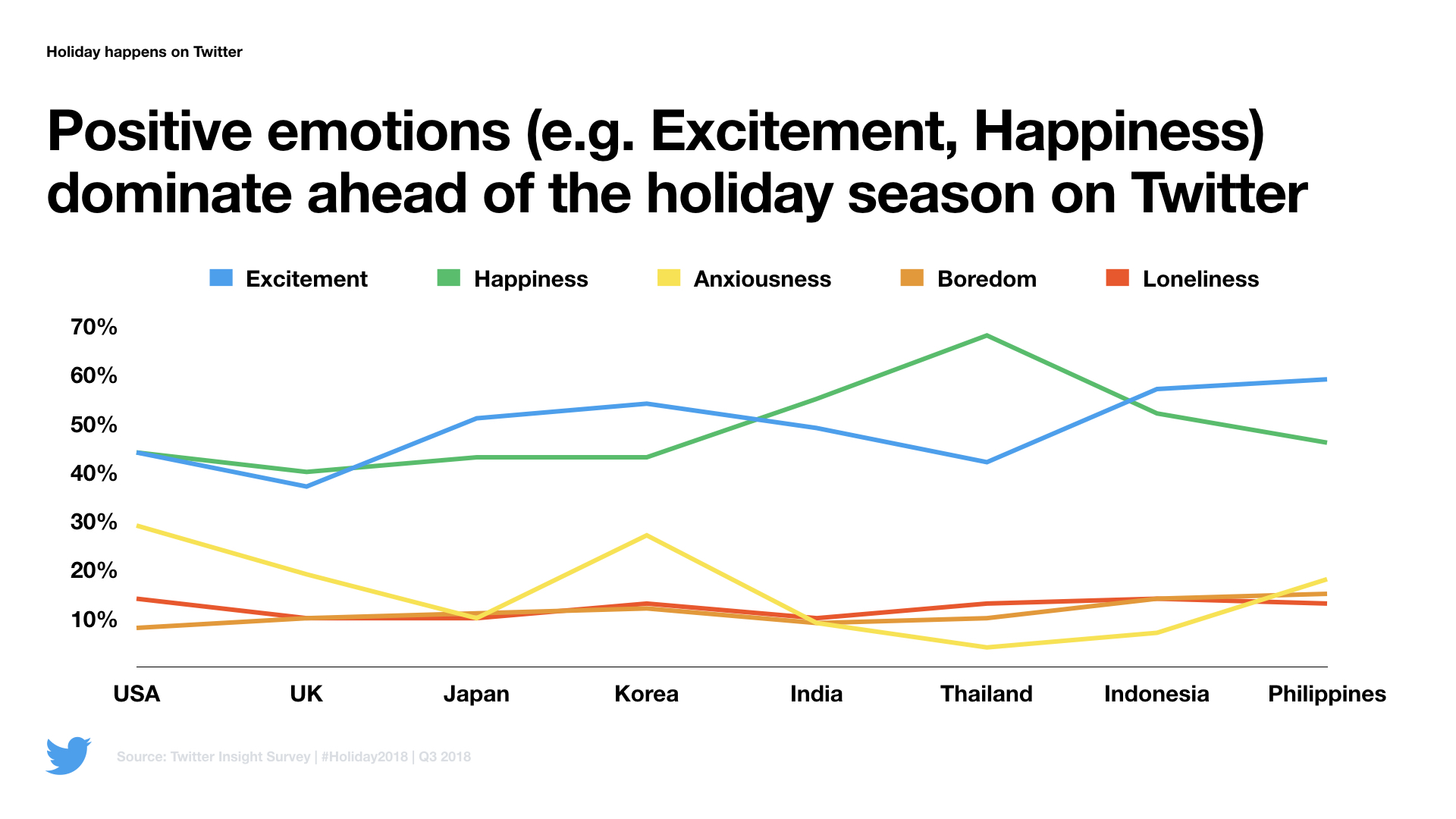
2. People from Southeast Asia and India are travelling more during the holidays.
As the holiday season gets closer to Christmas – this provides more downtime for families to gather together – many of which are spread within the country or throughout the region. On Twitter, 54% of our audience across Southeast Asia and India say they will be travelling more over the holiday season, with the highest coming from our Indonesian audience (67%). Southeast Asian families also lead the trend of multigenerational travel – a study by Agoda found that 66% of Thais and 54% of Indonesians have taken a holiday with grandparents, compared to 35% globally – as they take this shared downtime to travel together as a family before the new year starts.
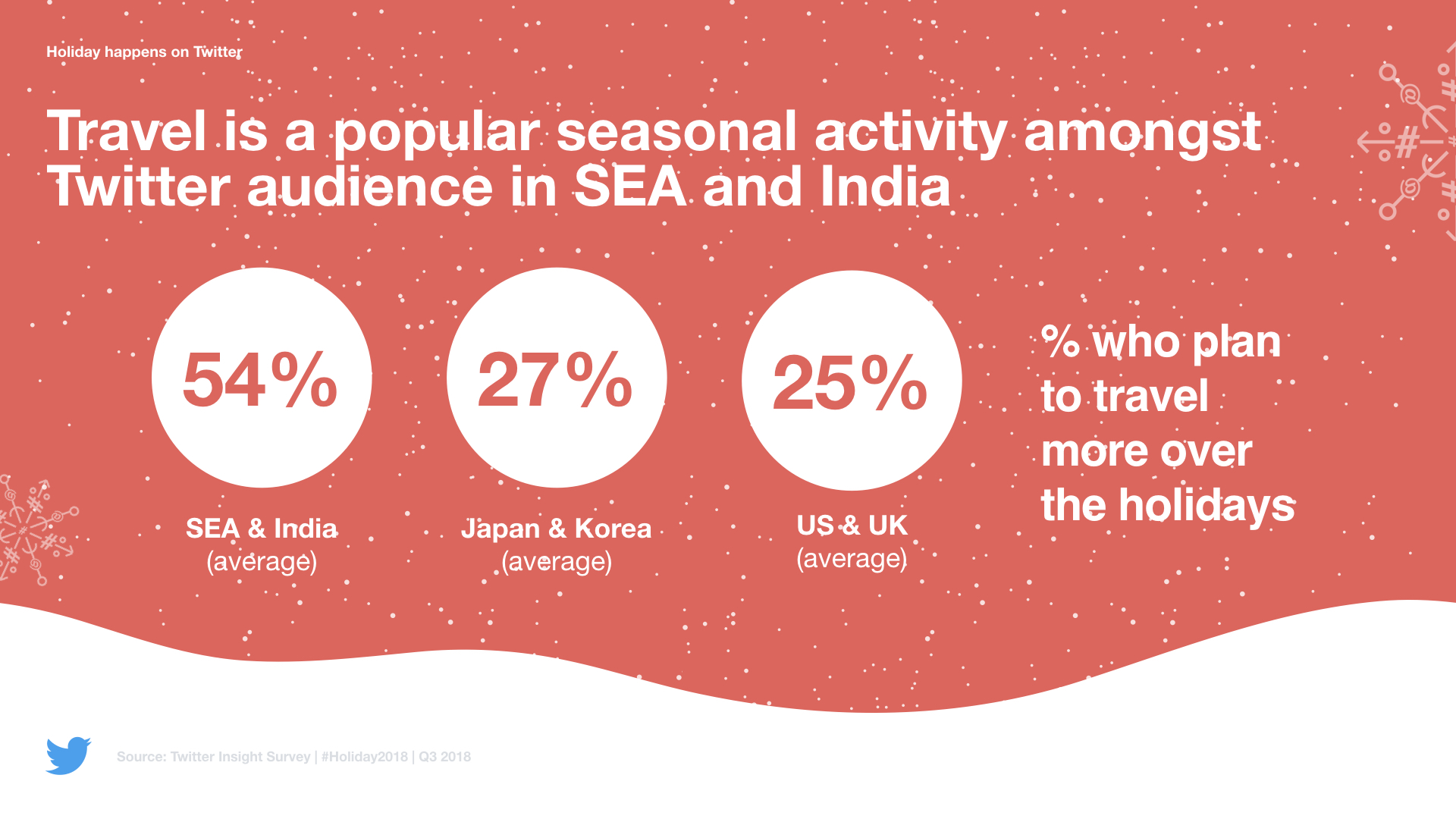
3. More Asian shoppers indulge in self-gifting
Holiday shopping is usually a time to shop for gifts for others as commonly seen in the US and UK. However, people on Twitter in Asia view the holiday season more as a time to treat themselves for working hard over the year. Nonetheless, Twitter’s US audience, who hit the stores or went online with the intention of shopping for others, often ended up buying a gift for themselves. The trend continued throughout December, with male shoppers more likely to continue buying for themselves late in the season.3

4. Newer holiday shopping events appeal more to Twitter users in emerging Asian markets.
While Black Friday remains the most popular holiday shopping event amongst US users, newer shopping events like Alibaba’s Singles’ Day (11 Nov.), JD.com’s ‘Double 12’ (12 Dec.), and Hari Belanja Online Nasional ‘Harbolnas’ in Indonesia (12 Dec.), see higher participation rates from the Twitter audiences in Asian markets. Advertisers can approach newer holiday shopping events with attractive offers and the right customer approach to broaden their offline and online sales horizon throughout the holiday season.4
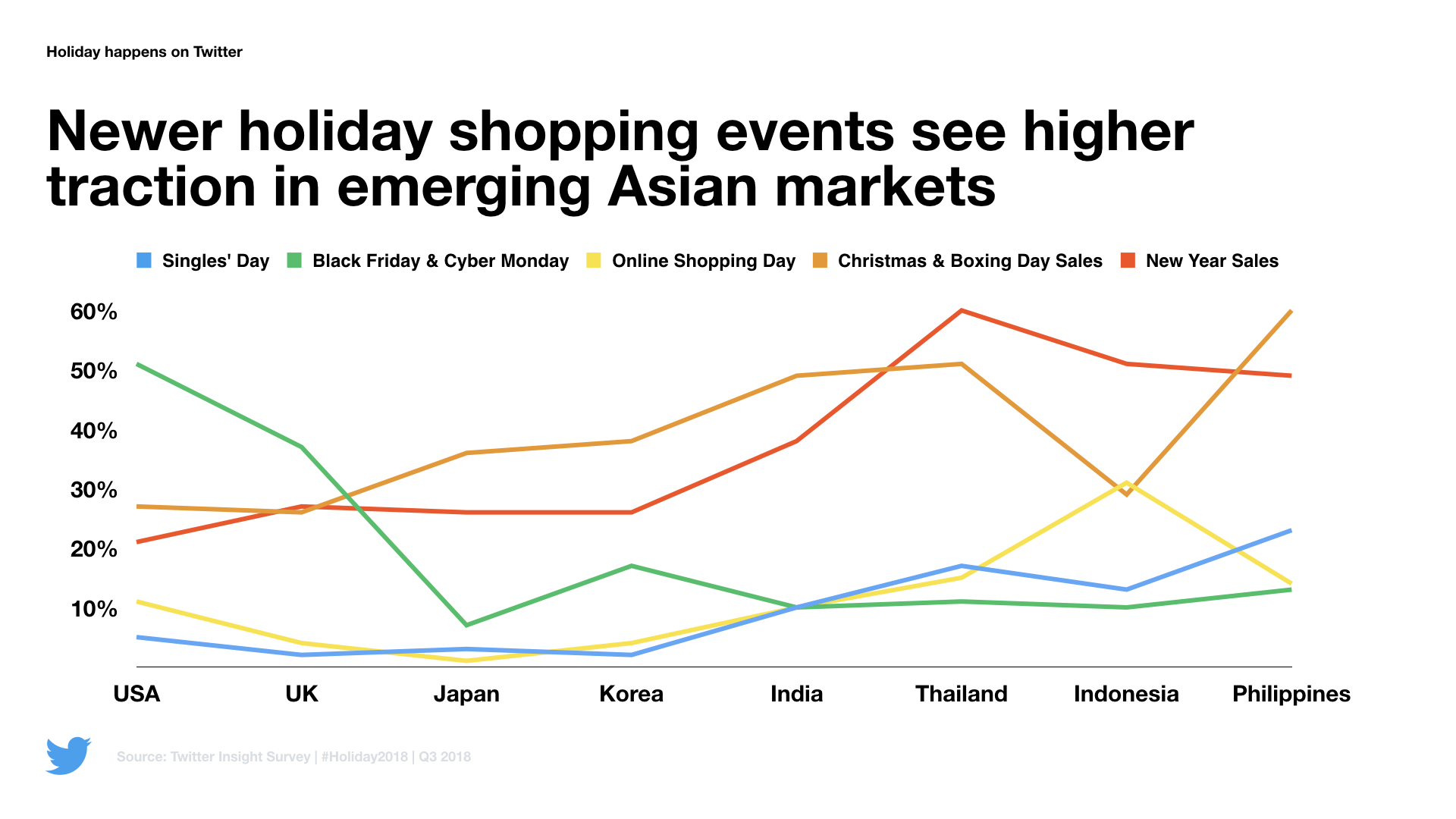
5. Desktop shopping sites continue to reign in the US and UK, while mobile shopping apps have risen to dominance in Southeast Asia and India.
Online mobile shopping has continued to gain favour as the shopping channel of choice, especially in Asia. 56% of users in Southeast Asia and India prefer shopping through mobile apps such as Shopee, Lazada, Amazon, Tokopedia, Bibli. In fact, 70% of orders on Lazada across Southeast Asia on Singles’ Day 2016 were made through mobile. Planning and optimising holiday shopping content (opening hours, product catalogue, promotions etc.) for mobile can help ease and facilitate customers’ purchase decisions, and in turn, drive more holiday sales conversions.5
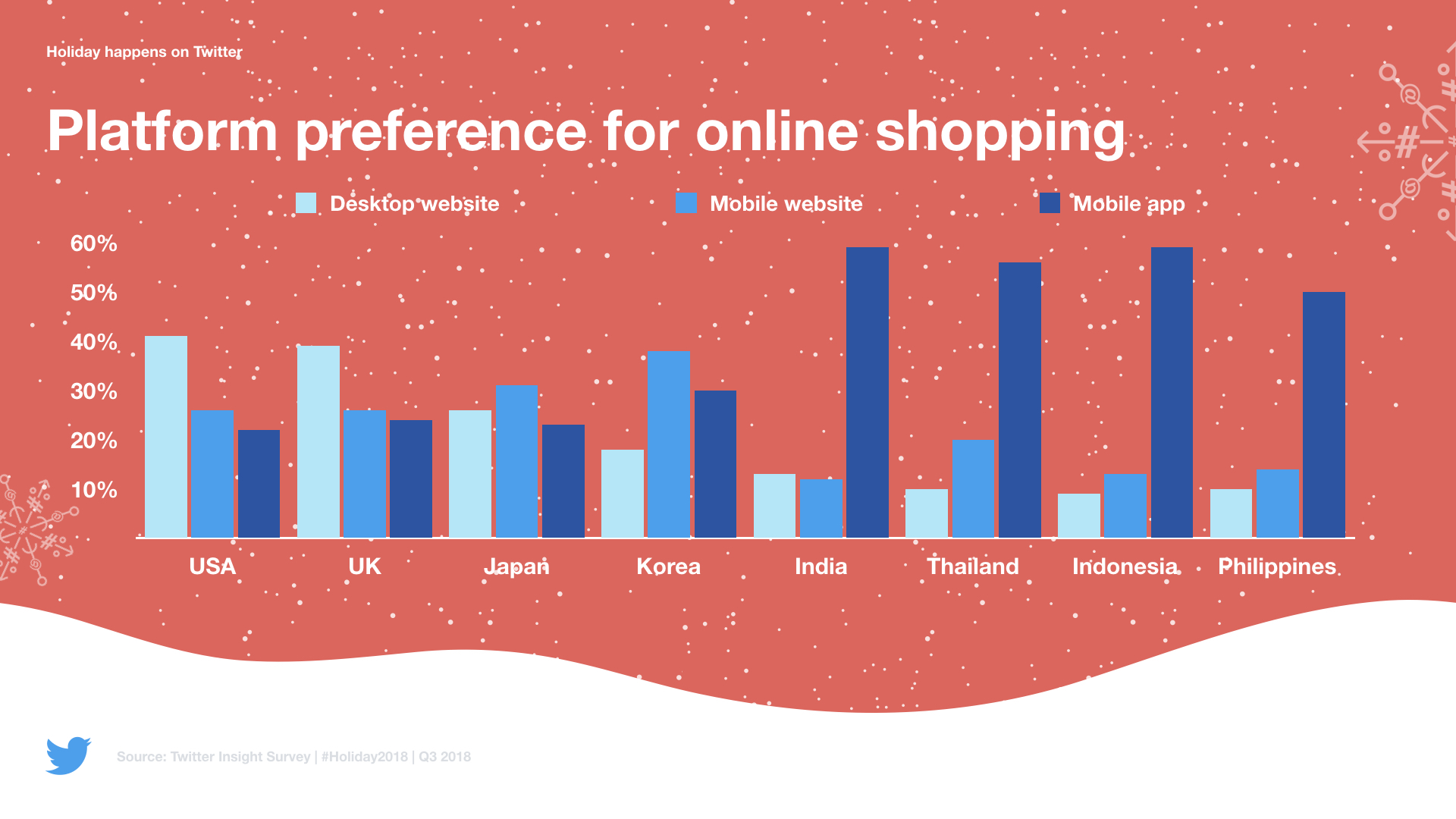
6. The audience on Twitter want to see more from brands during the holiday season.
The holiday spirit is out in full force by December. Even though it’s holiday crunch time, gift purchasing continues during this period as well. While people on Twitter look for holiday deals, they are also likely to be on Twitter to discover holiday content for inspiration on last-minute gifting, decorations, and party ideas. Provide creative messaging that are relevant to your target audience in terms of content and context, such as combining holiday content with useful store information (opening hours and returns etc.), to help consumers to make decisions in the final hour.

7. Omnichannel presence is key for brands and retailers to succeed this season.
Consumers today expect choices when it comes to engaging with brands and retailers. Those who succeed are the ones who allow their customers to choose how, when, and where they engage. As one might expect, more people on Twitter plan to shop online more than offline during the holiday season. However, in-store efforts cannot be ignored as 1 in 4 people on Twitter still look to do more shopping at malls. This is corroborated by a study by Bazaarvoice which found that 30% of consumers plan to do more online shopping this year compared to last, but nearly all (96%) plan to shop physically and digitally. Brands and retailers that connect their online and offline efforts to create a unified customer experience can better reach their target audience wherever they are, whenever their customers need to engage with them during this holiday season.
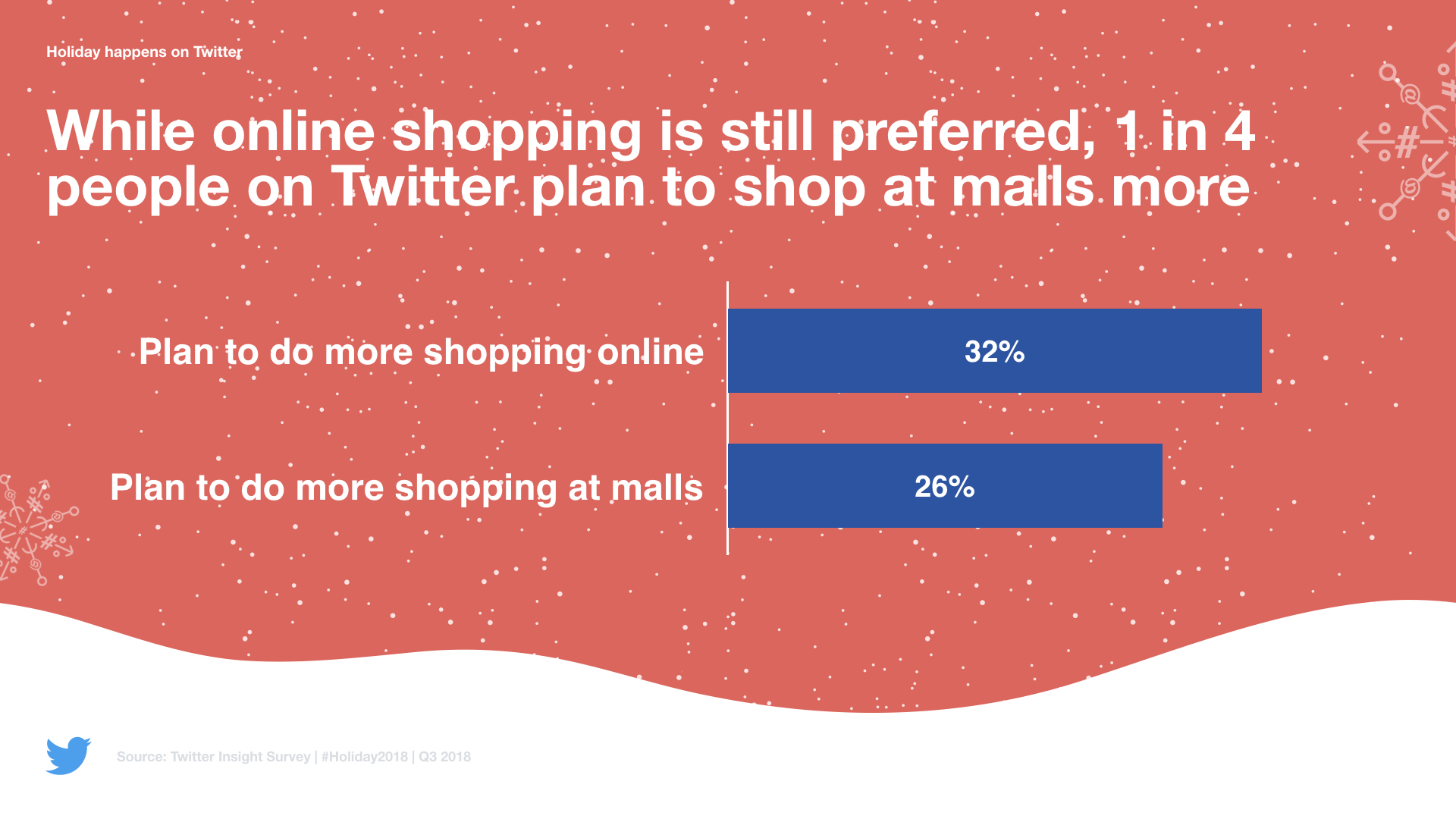
8. Twitter can increase foot traffic.
Recent research shows that 1 in 5 people on Twitter would go to a brick-and-mortar store if they saw a Tweet for a sale at a nearby retailer. And a 2017 study with Foursquare in the US found that Twitter campaigns increased foot traffic by 23%, outperforming Nielsen’s benchmark by 30%.6 If retail is your focus during the holidays, Twitter is well positioned to help you reverse falling foot-traffic. With 1 in 4 of the audience on Twitter still planning to make purchases offline, advertisers can leverage activation efforts through Twitter with relevant online holiday messaging and promotions, driving them directly to offline stores.
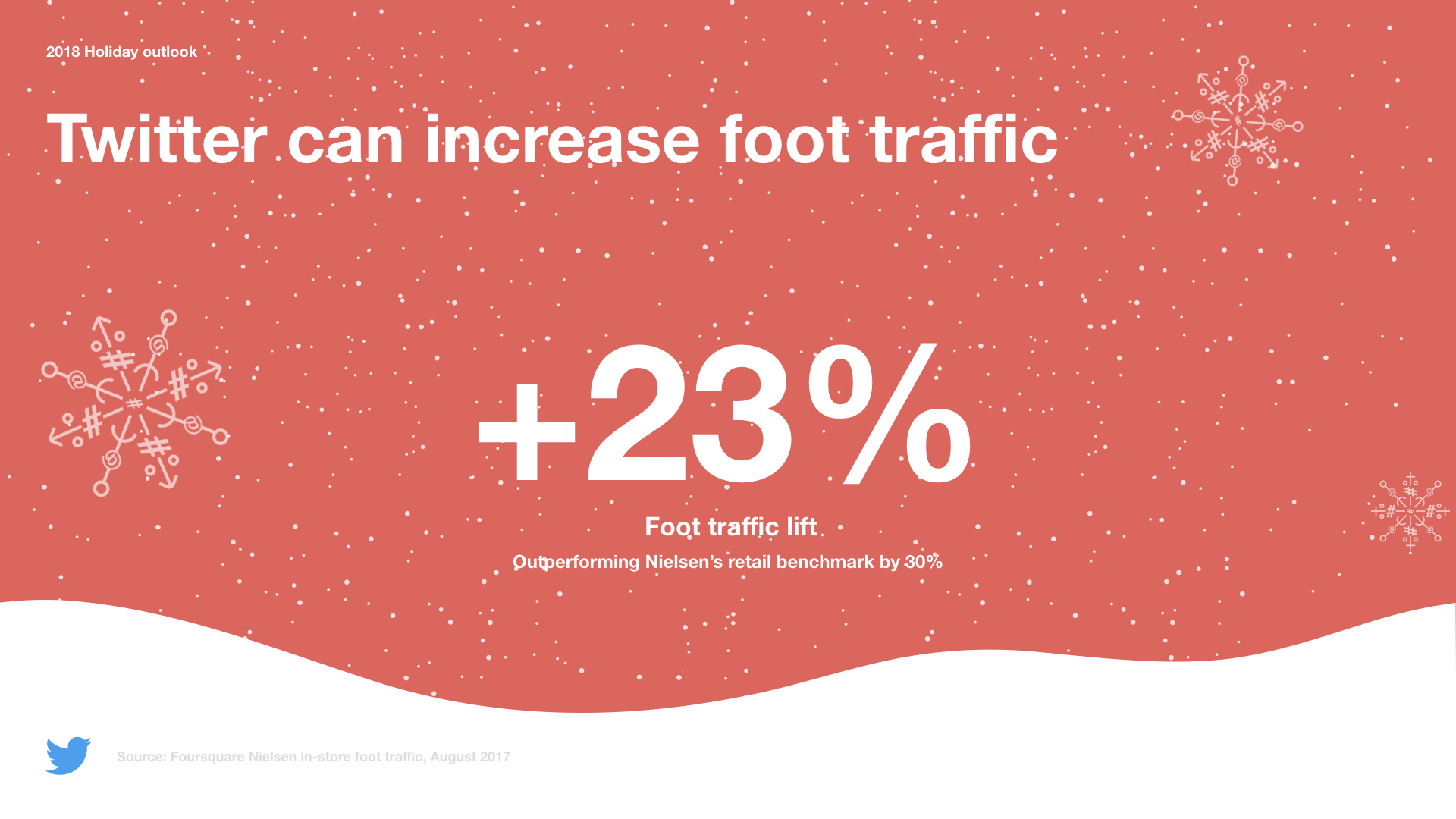
What does this mean for marketers?
With this information, marketers can speak directly and more effectively to a Twitter audience that’s already engaged and receptive to holiday messaging. And by understanding when they’re filled with holiday joy or holiday dread, you’ll be able to tailor your message directly to your audience. By digging into the insights from Twitter’s audience, you’ll also have a better sense of who you should target and when you want to message them during the holiday season. The holidays are a crucial time for most brands, and with these insights, you’ll be better prepared to position yourself in the crowded marketplace.
Methodology
Twitter surveyed over 10,000 Twitter respondents across eight markets to find out more about their attitudes towards the upcoming holidays and intended participation and motivations during year-end holiday shopping events. The survey ran from 24 Oct. to 30 Oct. 2018 on the Twitter platform, with markets covered being US, UK, Japan, Korea, India, Philippines, Thailand, and Indonesia.
Footnotes:
1 Twitter-commissioned study: Kantar Millward Brown, 2017
2 Global Web Index, Q3 2016
3 What's happening next: 9 holiday predictions every marketer should know
4 Payment Week, Wirecard International Holiday Shopping Report 2018
5 Retail Dive, Holiday-season mobile ads affected consumer browsing, shopping patterns: Adfonic
6 Foursquare Nielsen in-store foot traffic, August 2017